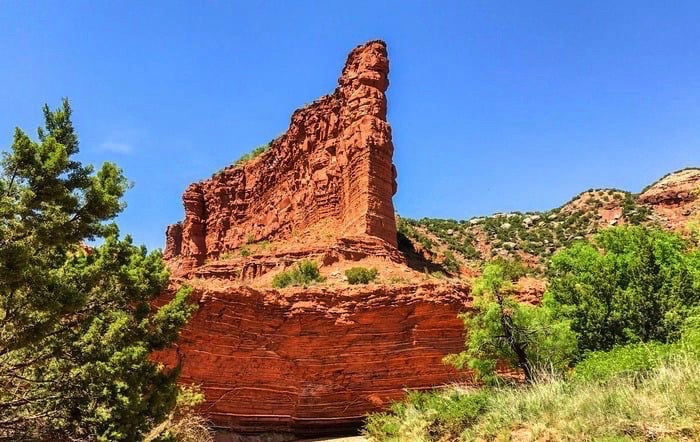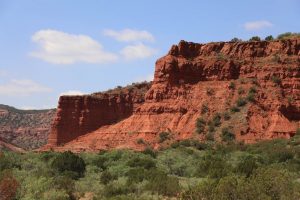
Texas Bluebonnets, photo credit, Bryan Hughes
As I delved into the history of the Lone Star State, beyond the events already familiar to me, I was surprised to learn that the largest ethnic group that migrated to Texas were the Germans.
From their first immigration in the 1830s, the Germans clustered in fragmented enclaves in a broad band across the south-central part of the state. The band became known as The German Belt. It stretched from Galveston and Houston in the east to Kerrville, Mason, and Hondo in the west, covering fertile, humid coastal plain to semi-arid hill country.
These voluntary migrations generally began with a person of dominant personality, a true pioneer. This natural leader was forceful and ambitious, someone who perceived emigration as a solution to the economic, social, political, and religious problems in their homeland. Such a person was Johann Friedrich Ernst, whose birth name was Friedrich Dirks but who began using the surname Ernst after leaving the area of Germany where he was raised. A professional landscaper, he immigrated to America intending to settle in Missouri, but while in New Orleans, he learned of large land grants available to Europeans in Stephen F. Austin’s colony in Texas. He then used the strength of his personality to persuade others to follow him to Texas.
In 1831, Ernst applied for and received a grant of more than 4000 acres in the northwest corner of Austin County. His land formed the nucleus of The German Belt. Through his many lengthy letters to friends in Germany, he reached and influenced prospective migrants. As a result of his “American letters,” the interest in emigration spread quickly, and a small, but steady stream of migrants left northwestern Germany for Texas. By the late 1830s, German immigration to the Lone Star State was widely publicized in the Fatherland.
The German settlers who came to Texas were solid, middle-class peasants, the majority of whom were ambitious farmers who believed that their futures in the Fatherland were cramped by the social and economic system. They weren’t poverty-stricken or oppressed. In fact, they could afford the cash investment required to move overseas.
Between 1844 and 1847, more than seven thousand Germans reached the new land, and by early 1850, the Germans numbered more than 5 percent of the total Texas population, a number that remained constant throughout the rest of the nineteenth century.
The 1990 census revealed that 17.5 percent of the total Texas population claimed pure or partial German ancestry. This chain migration continued until the Civil War when the Union blockaded the Confederate ports, halting all immigration.
After the Civil War ended, ships loaded with German immigrants once again disembarked at the Galveston wharves, which was the port of entry before Ellis Island opened in 1892. From 1865 to the early 1890s, it is estimated that the number reached 40,000.
In the 1890s, immigrants who had arrived earlier and had settled in the midwestern states of Illinois, Minnesota, and Iowa relocated to Texas, sponsored by the Flusche brothers and the Catholic Church. These Germans founded a colony at Muenster in North Texas. Also around this time, sizable numbers of Germans appeared in Texas cities, most notably in San Antonio, where one-third of the population was German.

Many German settlements of the time had distinctive architecture. In the Hill Country, settlers built half-timbered and stone houses with miles of rock fences and grand Gothic churches with jagged stone towers that reached skyward. They spoke a distinctive German dialect, ate sausages and sauerkraut, and drank Texas-German beers: Pearl and Shiner. They polkaed in dance halls, watched rifle competitions at Schützenfeste, and enjoyed the ancient Germanic custom of Easter Fires in Fredericksburg.
In the 1890s, German immigration to Texas peaked and began to taper off. Second- and third-generation German-Texans, looking for cheaper land, went westward until the Great Depression halted that movement.
By the early 1900s, the rural German communities received no additional immigrants from Europe, and later in the twentieth century, the older German ethnic sections in cities such as San Antonio broke apart as prosperous third- and fourth-generation Texas Germans flocked to the suburbs. It was also around this time that the San Antonio’s affluent German neighborhood – the King William Historic District – lost most of its German-American residents.
The settlers had survived the difficulties of pioneering, but in the years to follow, acculturation took a heavy toll. Then, two world wars and the associated anti-German prejudice damaged the interest in Germans and their culture, and by the early 1950s, an era had come to an end.
The Texas Germans who settled the Lone Star State were diverse: peasant farmers to intellectuals, Protestants, Catholics, Jews, and atheists, farmers and townsfolk, honest people and murderers, abolitionists and slave owners, teetotalers and drinkers. Mostly, they were hardworking, fun-loving people who had come seeking economic opportunities, and they all had a varied impact on the achievements and influence of Texas.
Side note: The Republic of Texas declared its independence from Mexico on March 2, 1836. But it wasn’t until December 29, 1845, that Texas became the 28th state in the United States.



 Having spent all day in the car, Bullet was content to sack out on his own bed near the picture window in the living room, in full view of the canyon cliffs.
Having spent all day in the car, Bullet was content to sack out on his own bed near the picture window in the living room, in full view of the canyon cliffs. On our first night at the cabin we had only one thing on our agenda—nothing! We carried our drinks to the flagstone patio to watch the sunset and relax.
On our first night at the cabin we had only one thing on our agenda—nothing! We carried our drinks to the flagstone patio to watch the sunset and relax.





